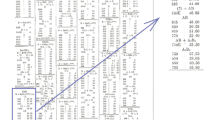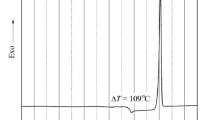Abstract
The limits of the glass-formation regions are established for the binary R′2−P2O5 and R″O5−P2O5 systems (R′=Li, Na, K: R″=Mg, Ca, Sr, Ba). It is shown that these boundaries closely correlate with those reported by other investigators despite the difference in the conditions in which these binary phosphate glasses were synthesized. The fact that all of the systems under study have about the same upper limits of glass-formation regions is attributed to the ratio R′2O(R′O): P2O5, which for the systems in question is 1.0–1.5 rather than the individual crystal-chemical characteristics of the R+ and R2+ cations.
Similar content being viewed by others
References
H. Rawson,Inorganic Glass-Forming Systems, London (1967).
J. Van Wezer,Phosphorus and Its Compounds Missouri (1958).
C. A. Elyard, P. L. Baynton, and H. Rawson,Glastechn. Ber.,32K(5), 36–42 (1959).
M. Imaoka,Advances in Glass Technology, Part 1, Plenum, New York (1962), p. 149.
A. N. Lazarev,Vibrational Spectra and Constitution of Silicates [in Russian], Leningrad (1968).
V. V. Tarasov,New Topics in the Physics of Glass [in Russian], Moscow (1959).
K. K. Strelov and A. V. Ivanova,Crystal Chemistry of Silicates and Refractory Oxides [in Russian], Sverdlovsk (1984).
Author information
Authors and Affiliations
Additional information
Translated from Steklo i Keramika, No. 2, pp. 13–15 February, 1997.
Rights and permissions
About this article
Cite this article
Mamoshin, V.L. Some aspects of glass formation in R′2O−P2O5 and R″O−P2O5 systems. Glass Ceram 54, 45–47 (1997). https://doi.org/10.1007/BF02767143
Issue Date:
DOI: https://doi.org/10.1007/BF02767143




